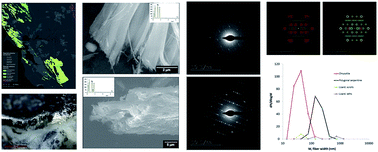Analysis of serpentine polymorphs in investigations of natural occurrences of asbestos
Abstract
This work investigates potential analytical variability in environmental investigations of natural occurrences of asbestos (NOA) due to intergrown serpentine minerals. Franciscan complex and serpentinite rock samples were obtained from likely NOA sites in coastal Northern California with geographic information system (GIS) maps, then analyzed using polarized light microscopy (PLM), transmission electron microscopy with energy-dispersive X-ray analysis and selected area electron diffraction (TEM/SAED/EDS), and environmental scanning electron microscopy with EDS (ESEM/EDS). Non-asbestos serpentine fibers were superficially similar to chrysotile but were differentiated quickly using TEM morphology criteria and reference SAED overlays. 94 NOA fibers were classified as asbestiform chrysotile (62%), polygonal serpentine (34%), lizardite scrolls (2%), and lizardite laths (2%). Chrysotile fibril widths (mean = 42 nm) were significantly different from those of polygonal serpentine and lizardite laths (167 and 505 nm, respectively), but not lizardite scrolls (37 nm). Due to differing preparations and microscope resolutions, TEM analyses investigated a distinct, smaller population of particles (0.01–10 μm) than did PLM analyses (10–100 μm). A higher proportion of asbestiform phases in the finer fraction could potentially bias TEM bulk percent asbestos determinations. ESEM/EDS of intermediate particle size ranges revealed 20–200 μm, elongated particles with intermixed asbestiform and non-asbestiform structures on their surfaces. These particles were too thick and complex to be resolved by PLM, and too massive to be detected by TEM. These large particles are likely to exist in samples prepared by mechanical crushing or grinding, but are not likely to be generated by “releasable asbestos” methods.


 Please wait while we load your content...
Please wait while we load your content...